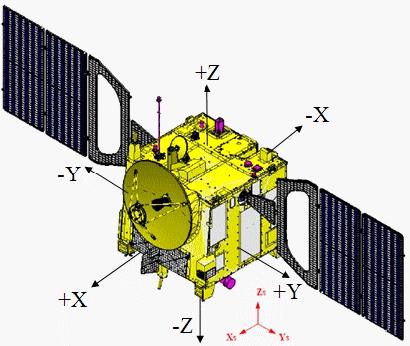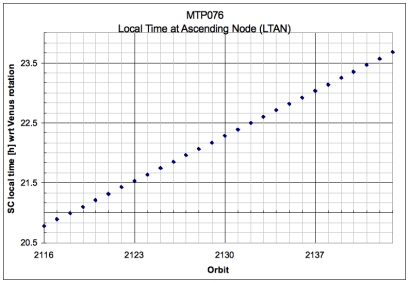Terminator orbits
A planet's terminator is the point where the transition from light to dark (from the Sun-side of the planet to its night-side takes) place. Due to the intensity of solar radiation at Venus and the thermal constraints on the operation of Venus Express, special observations can be performed as the spacecraft passes over or near the terminator.
The position of a point on the surface of a planet relative to the Sun, or its solar time, can be described by the 'local time'. At the point where the Sun is at its highest elevation relative to the planet, it is noon or 12:00. The solar time at the middle of the night side is midnight or 24:00. At the point where the Sun rises, it is 06:00; and where the surface transitions from light to dark, it is 18:00. Thus, terminator orbits have a local time of 06:00 and 18:00.
Observations in the terminator orbits
Terminator orbits can be useful for observations with some of the instruments on Venus Express. The VMC (Venus Monitoring Camera) uses image data to track the movements of the clouds and carry out long-term studies of wind speeds. These data are often obtained as close as possible to the planet so that cloud features can be imaged in the highest possible resolution. These high-resolution images can then be used to derive localised wind speeds. The data for these observations are obtained at pericentre, when the spacecraft is above the North Pole of Venus.
An alternative method used by VMC to image the planet is to take images from further away. Although these images are of a lower resolution, they show the entire disc of the planet and provide information on relative wind speeds at widely dispersed latitudes and longitudes. When Venus Express is in a terminator orbit, the spacecraft skips its normal Earth communications pass and takes images of the Sun-side for 24 hours, tracking the terminator around the planet. As the spacecraft orbit varies from about 66,000 kilometres from the planet at apocentre, to 175 kilometres at pericentre, images can be taken at widely varying distances, and therefore with varying resolution. This longer coverage has the potential to provide interesting results.
 |
|
Schematic figure of the Venus Express spacecraft with the faces labelled. Credit: ESA |
Instruments such as the VIRTIS imaging spectrometer can make use of the terminator orbit by imaging the Sun-side without violating thermal constraints. The instruments are mounted on the +Z face of the spacecraft. The +Z and +X faces of the spacecraft are built to withstand solar exposure for as long as necessary. Every other face of the spacecraft can only be exposed at certain angles and for limited times. At noon local time, pointing the instruments (on the +Z face) directly down at the planet keeps the -Z face illuminated. This is called a 'hot' orientation; in this case there are limitations on the time for which the spacecraft can remain illuminated, and at what angle.
While in the terminator orbit, it is possible to point the +Z face of the spacecraft (and the instruments) towards the Sun-side, keeping the -Z face pointed away from the Sun. This is called a 'cold' observation, and such observations can be carried out for as long as necessary. In a terminator orbit, the spacecraft points slightly towards the day side, allowing for imaging of illuminated clouds without thermal and time constraints.
Local Time at Ascending Node
The figure below shows the evolution of the Local Time at Ascending Node (LTAN) for a particular planning period. Venus Express is in a fixed inertial orbit (the orbit is 'fixed' relative to a reference point among the stars), and the planet rotates below the spacecraft. Every orbit, Venus rotates by about 3 degrees as compared to its location in the spacecraft's previous orbit.
 |
|
Local time at ascending node for Venus Express. Credit: ESA |
The ascending node is the point in the orbit where the spacecraft crosses the equator and travels 'up' towards the North Pole. In every orbit, the ascending node is above a certain point on the ground at the equator. The local time of that point is plotted in the figure; it tells us the relative Sun angle on the spacecraft in each orbit. If the orbit ascends over local noon (12:00), then pointing the +Z face towards nadir would put the Sun directly on the -Z face, which is very hot and not allowed. At a local time of 06:00 and 18:00, in the terminator orbits, pointing the +Z face to nadir ensures that solar illumination is only incident on the +X face, and the -Z face is not illuminated at all (the Sun is at 90°). This is thermally benign. If the spacecraft is pointed at Venus's Sun-side in that terminator orbit, the +X and +Z faces are illuminated, keeping the -Z face completely cold. This way, there are no restrictions on how long Sun-side data can be recorded. In orbits close to the terminator, it is possible to point towards Venus's Sun-side and keep the -Z face cool. During these terminator orbits or 'near terminator' orbits, the VIRTIS imaging spectrometer usually performs long sequences of observations, starting directly above the South Pole and continuing almost until pericentre.
